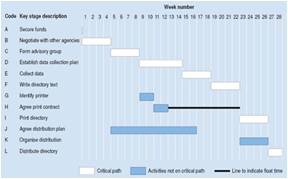7 Essential Project Performance Measures
by Stacey Barr |Project performance measurement isn’t just on-time and on-budget. Here are 7 ways for how to measure project performance meaningfully.

When we think about project performance measurement, it’s not really the same as measuring the performance of a team or a business process or an organisation’s strategy. So we need to think a little differently about the kinds of measures that will tell us what we really need to know to manage project performance.
When we measure the performance of the business process or team, we’re interested in how a particular business result produced by that process or team is changing as time goes by. When we’re measuring the performance of a project we are interested in the impact the project has at a point in time, or over a fixed timeframe.
This is because projects by their very definition have a start point and an end point. The reason we do projects is to make a difference and usually the difference we’re trying to make is to make some kind of result, especially in business, better. Thus, our first project performance measure is…
Project KPI #1: Direct Impact
The size of a project’s impact on a business performance measure is a measure of a project’s success. It’s the the difference between the level of performance before the project’s start time, and the level after the project’s end time. You can easily measure the direct impact of a project with an XmR chart of the business performance measure the project aims to improve.
Project KPI #2 & #3: Financial Impact & ROI
A project won’t be successful if the cost of doing it was not sufficiently lower than the value of its impact. So, we need two other important measures of project success. The first one is financial impact, like costs saved or income generated. The second one is the return on investment, or ROI, which is the ratio of that financial impact to the total costs of undertaking the project.
Project KPI #4 & #5: On-time & On-budget
These are the traditional project measures, which can also help us manage the project while we’re implementing it. A well-managed project is more likely to have a big impact and big ROI. This is where the most commonly used measures of project performance come in: on-time and on-budget. But rather than just measuring these at the end of the project, they can be measured at regular milestones throughout the project, so we have opportunities to a project’s implementation back on track before it’s too late.
Project KPI #6 & #7: Stakeholder Support & Engagement
Not many projects can succeed if they don’t have the support of the people they will affect. Nor will they succeed if the important stakeholders don’t feel engaged along the way. Stakeholder perception of value can be a good proxy to measure support. And a good way to monitor stakeholder engagement might be the amount of stakeholder participation in project tasks and events.
Your Project Performance Measure Checklist
So we now have a basic framework of the project performance results that are worth measuring, and it can be somewhat of a checklist for what types of KPIs to design for your project:
- Business financial impact
- Business performance measure impact
- ROI
- Milestones completed on-time
- Milestones completed on-budget
- Stakeholder perception of value
- Stakeholder participation
With these seven result areas for project performance, the next step is to decide how to choose the tailored KPIs to measure them. There is no one right answer to this, because each project is different. But there is a step-by-step measure development process to help you design the quantitative measures right for your project.
DISCUSSION:
What frameworks do you use for measuring project performance?
Connect with Stacey
Haven’t found what you’re looking for? Want more information? Fill out the form below and I’ll get in touch with you as soon as possible.
167 Eagle Street,
Brisbane Qld 4000,
Australia
ACN: 129953635
Director: Stacey Barr




